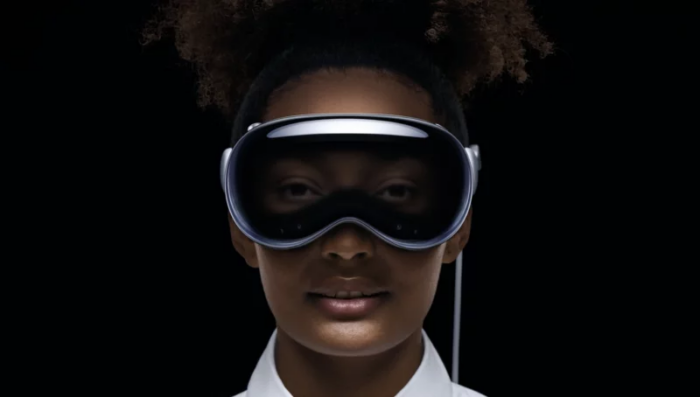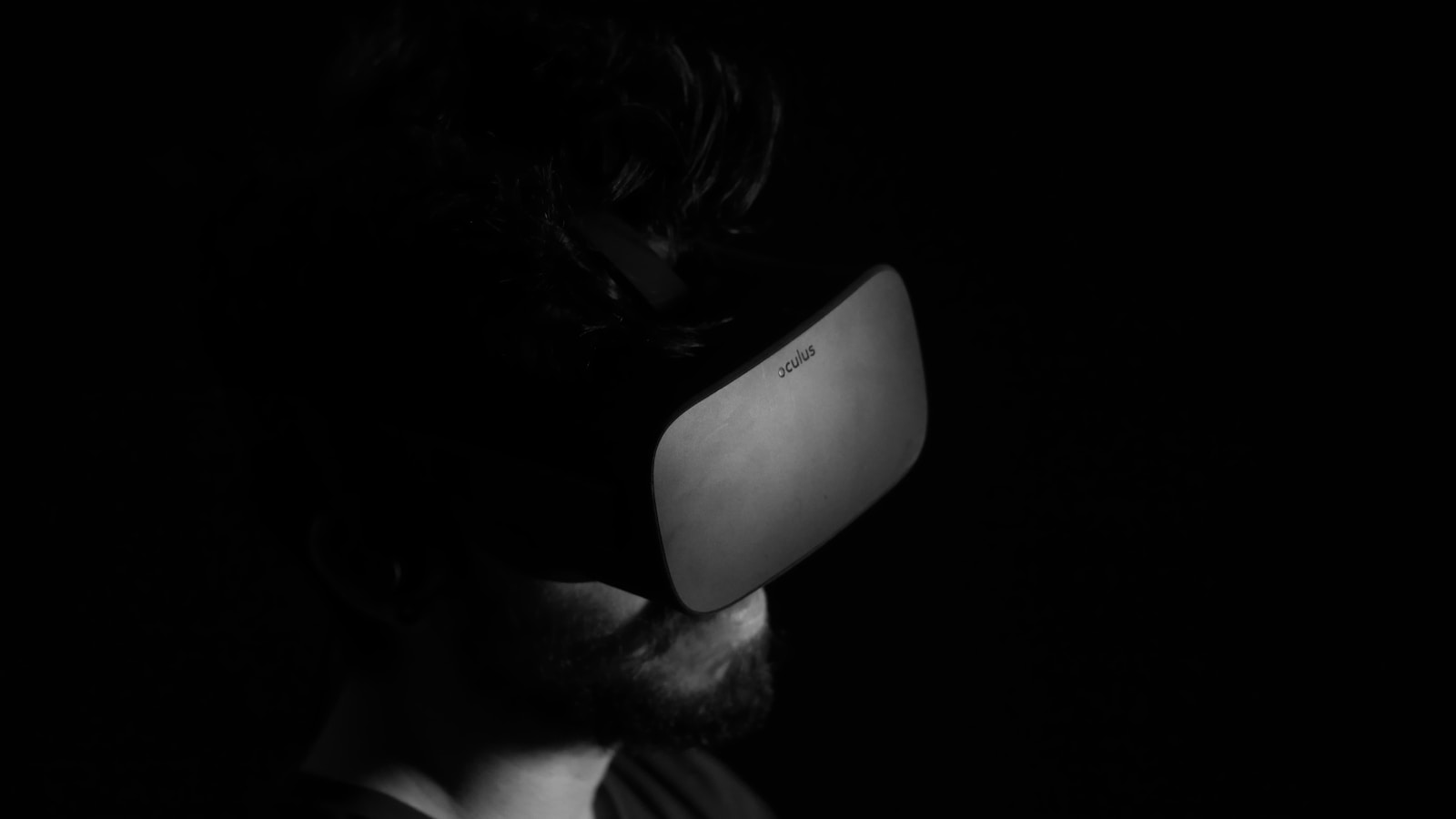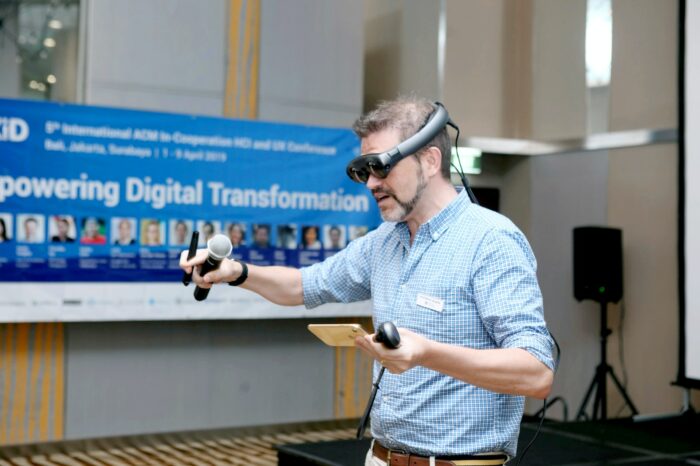Introduction
In our exploration of spatial computing, we will take a comprehensive look at various aspects, including its origins, applications, investment opportunities, and more. This technology has a fascinating history, having evolved from its roots in augmented reality and virtual reality. We will delve into its historical development and the key milestones that have brought us to the current state of spatial computing. In the following section, we will offer a detailed and accessible explanation of spatial computing and its origins.
ToC
What is Spatial Computing?
Defining spatial computing depends on who you ask.
In 2003, Simon Greenwold, from Yale University through MIT, coined the term ‘spatial computing.’ In his MSc dissertation, he described spatial computing as remarkably similar to concepts we now know as augmented reality (AR) and mixed reality (MR).
Greenwold’s definition was succinct:”I define spatial computing as human interaction with a machine in which the machine retains and manipulates referents to real objects and spaces… [A] system that allows users to create virtual forms and install them into the actual space surrounding them is spatial computing.”
However, a more expansive interpretation of spatial computing has emerged over time, encompassing enabling technologies like the Internet of Things and Speech Recognition. For instance, a scenario where sensors within an industrial complex collect data and feed it into a centralized Edge Computer, which is then simulated virtually, falls under the umbrella of spatial computing. Even everyday devices like Amazon’s Echo smart speakers and Google’s Nest, equipped with virtual assistants like Alexa and Google Assistant, are considered spatial computing.
Yet, in June 2023, the broader definition of spatial computing began to converge with Greenwold’s concept as Apple entered the Immersive Technologies scene with a premium mixed reality headset, Apple Vision Pro. In true Apple fashion, the tech giant avoided terms like “virtual” or “mixed reality” and didn’t use the word ‘metaverse’.
However, no matter how much Apple executives will convince you otherwise, the Apple headset is a mixed reality device and is considered under the umbrella of the Metaverse Nexus.
In extension, the definition of ‘spatial computing’ can be seen as another term for ‘mixed reality,’ which is another term for ‘augmented reality.’

Spatial Computing vs. Augmented Reality – What Sets Them Apart?
Making matters worse, isn’t mixed reality the same as augmented reality? In practicality, yes; in technicality, no.
From a technical perspective, augmented and mixed reality share a common core: the ability to integrate digital objects seamlessly into the physical environment. The distinction lies in how this integration is achieved..
A virtual reality (VR) headset is a ‘closed’ experience. You only experience and interact with the virtual world strapped onto your head. Yet, a VR headset can use an amalgamation of computer vision, sensor fusion, and spatial mapping. Combining these are when sensors and cameras film and track the world around you in real time, show it in the headset and enable you to place virtual objects in it. Through this technique, VR headsets turn into mixed reality.
An augmented reality headset on the other hand was designed from the start to enable you to place, create, and manipulate virtual objects in the real world. You therefore don’t see the environment through a camera feed but by looking through special glass.
In practical terms, mixed and augmented reality are essentially the same. In both cases, users engage with digital objects that seamlessly blend into their physical surroundings. For example, when redesigning your dining room, you can choose between numerous depictions of dinner tables: shape, material, color, finish, size, and so on. As you sift through the virtual replicas of dinner tables each variant reflects uniquely and accurately the light in your dining room, even when you add another light source. You can even partially obscure your virtual trial table with your physical chairs around it.
This experience is practically the same irrespective of what headset — mixed or augmented reality — you use.
Conclusively, spatial computing is just Apple’s way of saying ‘mixed reality,’ which, in practice, aligns with augmented reality.
Spatial Computing Applications
Spatial Computing in Healthcare
Surgeons have embraced Augmented Reality (AR), Mixed Reality (MR), and spatial computing technologies to revolutionize the field of medicine. These advanced innovations provide surgeons with invaluable tools for visualizing complex patient anatomies and conditions, meticulously planning surgical procedures, and accessing real-time anatomical references and vital information.
In the realm of medical education, AR and MR technologies have made their way, although they may have some graphical limitations compared to the full potential of augmented reality.
One impressive example of AR technology in surgery is the SentiAR platform. This platform creates a holographic augmented reality experience in the operating room, allowing surgeons to immerse themselves in a three-dimensional representation of a patient’s specific anatomy. This offers profound insights into the patient’s condition during the surgery itself.
Furthermore, Stanford Medicine has developed a highly regarded virtual reality system that seamlessly integrates data from MRI scans, CT scans, and angiograms to create a dynamic three-dimensional model. Physicians and patients can interact with this model, similar to participating in a virtual reality game. During surgery, surgeons can overlay this detailed 3D rendering of the patient’s anatomy onto the real-time video feed, providing an unprecedented level of detail that goes beyond what traditional video feeds can offer.
Spatial Computing in Gaming and Entertainment
Spatial computing has found a unique and distinctive place in the world of gaming, especially in the realm of immersive party games exemplified by titles like Demeo. However, the entertainment possibilities within spatial computing are incredibly diverse.
Demeo, an engaging dungeon crawler game, sets itself apart by adopting a layout reminiscent of traditional board games. In this captivating adventure, up to four players come together as an adventuring team, strategically placing their figurines on a virtual board. What makes the VR version of Demeo special is its tactile immersion. Players can physically interact with the game environment, whether it’s picking up their gaming pieces or rolling dice with a simple motion controller flick. Even in its direct PC adaptation, the gratifying tactile engagement remains, ensuring a consistently enjoyable experience for players.
It’s worth noting that Demeo is recognized as one of the pioneering “immersive” games designed for the Apple Vision Pro, underlining its significance in the evolution of spatial computing gaming.
While party games like Demeo undoubtedly have a prominent place in spatial computing gaming, this landscape is further enriched by a wide range of entertainment experiences, as demonstrated by the intriguing examples offered by the Vision Pro. Users can effortlessly transport themselves to a virtual home theater or experience the thrill of sitting courtside at an NBA game.
Spatial Computing in Architecture & Construction
The convergence of Mixed Reality (MR) and Augmented Reality (AR) with Building Information Modeling (BIM) and Computer-Aided Design (CAD) represents a powerful fusion of technology and architecture.
Within the domain of MR/AR BIMs and CADs, architects and engineers gain access to a powerful toolkit. They can collaboratively interact with a virtual architectural model (CAD) in the MR environment, seamlessly transitioning it into a full-fledged VR environment when desired. This flexibility empowers architects to examine their designs in intricate detail.
BIM involves the creation and management of digital representations that encompass both the physical and functional aspects of architectural spaces, while CAD involves using software to craft 2D and 3D models of physical objects. The integration of MR/AR into these frameworks allows for the rapid conversion of CAD data into immersive virtual spaces, providing architects, engineers, and builders with a wide range of options.
The adoption of MR/AR BIMs and CADs represents a groundbreaking shift in design methodology. These technologies enable architects and engineers to immerse themselves in their designs, leading to a deeper understanding of spatial relationships and aesthetics. Additionally, they facilitate seamless collaboration as team members come together in shared virtual environments, transcending geographical constraints.
The incorporation of Mixed Reality (MR) into BIM and CAD design offers numerous benefits, including early error detection, cost and schedule optimization, improved collaboration, enhanced visualization, and better communication. Detecting errors early on helps prevent costly corrections during construction, and precise collaboration supports efficient cost and schedule management. MR provides a common information platform for all stakeholders and enhances visualization by displaying designs in life-size proportions, ultimately reducing project delays.
Notably, MR expedites the construction of conduit systems by offering a direct visualization and construction interface based on BIM data, thereby accelerating the entire process.
In summary, the integration of Mixed Reality into BIM and CAD design exemplifies the transformative potential of spatial computing. It seamlessly incorporates advanced technology into everyday architectural practices, offering architects and engineers an immersive exploration of their designs. Through MR/AR BIMs and CADs, the world of design enters a new era where the virtual and physical realms harmoniously merge.
Spatial Computing in Training and Skill Development
In the domain of employee onboarding, reskilling, and upskilling, spatial computing is emerging as a revolutionary tool that leverages virtual environments to replicate real-life situations. This innovation provides employees with a safe and controlled space to refine and expand their skill sets. For instance, virtual reality (VR) can be particularly valuable in training personnel to become proficient in operating heavy machinery or performing intricate tasks that require specialized expertise.
However, spatial computing doesn’t stop at simply adding realism to these training experiences; it also has the potential to enhance traditional onboarding and learning processes. By creating virtual spaces, organizations can bridge geographical gaps seamlessly, offering remote employees a genuine sense of presence and enabling them to connect with colleagues. Imagine the ability to simulate physical workspaces where remote team members can interact, collaborate, and work on projects, all from their remote locations, as if they were in the same room.
Spatial computing is a versatile tool for improving employee training in various ways. Here are some additional aspects to consider:
- Adaptive Learning Paths: Spatial computing can personalize learning experiences by adjusting content and challenges based on an individual’s progress and skill level. This tailored approach ensures that each employee receives training tailored to their unique needs and abilities.
- Real-time Feedback: By integrating sensors and feedback mechanisms into spatial computing environments, employees can receive immediate feedback on their performance. This real-time input allows for continuous improvement and adjustments during the training process, leading to faster skill acquisition.
- Multi-user Collaboration: Spatial computing can enable collaborative learning experiences by allowing multiple employees to join the same virtual training session simultaneously. This not only promotes teamwork but also facilitates peer-to-peer learning, where colleagues can share insights and tips in real time.
- Remote Expert Assistance: In complex training scenarios, spatial computing can enable subject matter experts to provide guidance and support to trainees remotely. This remote assistance can be invaluable for troubleshooting, ensuring safety, and fine-tuning skills.
- Data-driven Insights: Spatial computing systems can gather and analyze data on employee performance during training. This data can be used to pinpoint areas for improvement, track progress, and make data-driven decisions to continuously optimize the training process.
- On-demand Learning: With spatial computing, employees can access training modules on-demand, allowing them to refresh their skills or acquire new ones as needed. This flexibility empowers employees to take control of their own development and adapt to changing job requirements.
- Gamification Elements: Incorporating gamification elements into spatial computing-based training can make learning more engaging. Points, challenges, and rewards can motivate employees to actively participate and excel in their training.
- Scenario Simulation: Beyond realistic scenarios, spatial computing can simulate rare or high-risk situations that employees might encounter infrequently. This prepares them for even the most challenging and uncommon real-world scenarios.
- By integrating these elements into spatial computing-based training, organizations not only enhance skill acquisition but also revolutionize the entire learning experience, making it more effective, engaging, and adaptable to the evolving needs of both employees and organizations.

Spatial Computing in Manufacturing
Spatial computing is making a significant impact in the manufacturing sector, particularly in the realm of maintenance and repair tasks. It involves the use of augmented reality tools, such as smart glasses, which technicians can utilize to overlay instructions and diagrams onto physical equipment during repair work. This greatly enhances their ability to quickly identify and address issues, eliminating any guesswork and expediting the maintenance process. Moreover, AR facilitates knowledge transfer, allowing technicians to access relevant materials like manuals and guides or engage in video conferencing with remote experts.
Furthermore, spatial computing has applications in streamlining inspections, facilitating remote expert support, and providing on-demand training. Manufacturers and service organizations can improve communication by sharing carefully curated information, including images, videos, PDFs, and drawings related to specific equipment models and serial numbers. This accelerates the exchange of information for tasks like installation, servicing, repairs, and parts knowledge among field service engineers, technical support representatives, and customers.
Additionally, spatial computing contributes to optimizing factory performance, minimizing unexpected production downtime, and effectively planning maintenance. With AR technology, production area models can be projected onto the actual environment, allowing for advanced assessments of machine layouts, storage areas, transportation, and escape routes. This proactive approach enables optimization and improvements before equipment is commissioned.
In summary, spatial computing has the potential to revolutionize the manufacturing industry by providing precise and context-aware guidance precisely when and where it’s needed. It streamlines processes, enables real-time error detection, and empowers workers to promptly address issues, preventing disruptions in production.
Top Spatial Computing Headsets
Apple Vision Pro

We would be remiss if we didn’t include Apple’s titular mixed reality headset Apple Vision Pro. While Apple avoids the term “mixed reality,” the Vision Pro offers a mind-boggling experience. It combines crisp visual immersion with an intuitive user interface. Users can seamlessly interact by simply looking at objects and using hand gestures.
While enterprises might opt for more advanced – and expensive – mixed reality headsets, the Apple Vision Pro serves as Apple’s strong entry into the metaverse and the world of spatial computing.
Varjo XR-3
The Finnish company Varjo brings us the XR-3, a top choice for enterprise applications. Uniquely, what signifies this headset besides the flawless motion tracking and creator cloud software, is Varjo’s trademarked Bionic DisplayTM technology. Simply, the XR-3’s four display setup mirrors how our eyes naturally see the world and thus experiencing virtual environments in the XR-3 is akin to looking out your window in visual fidelity. The XR-3 stands as one of the most capable mixed reality headsets on the market.
Magic Leap 2
Where the Varjo XR-3 is the most advanced mixed reality headset, the Magic Leap 2 is the sophisticated augmented reality headset. Numerous pivotal features can be highlighted, but Dynamic Dimming is our personal favorite. In a nutshell, the Magic Leap 2 will draw a thin and occluded outline around virtual objects making them stand out from the world around you. Practically, this means you can read intricate text and labels, something before the ML2 wasn’t possible.
Meta Quest Pro
The mixed reality headset Meta Quest Pro initially met with mixed reviews. And while most critical comments were justified, the company behind the headset, Meta, is notorious for consistent updates improving the headset while introducing a steady stream of new features.
Lynx R1
The Lynx R1 mixed reality headset is the epitome of specifications that don’t dictate quality. On paper, Lynx R1 may appear to lag behind competitors in terms of components and display resolution by about a year. Yet, the actual experience far exceeds that of headsets, double or even triple its price tag. In all honesty, if you are curious about mixed reality and what all the fuss is about, the crowd-funded Lynx R1 is the first headset you should look at.
HTC Vive XR Elite
Lastly, we highlight HTC’s recently released Vive XR Elite for two reasons: clever design choices, and superior video passthrough. Starting with the design, HTC took a page from its previous headset HTC Flow, and enabled a lightweight tethered glasses form factor. Effectively, this means you can sit at your desk with floating virtual monitors, wearing the Vive XR Elite, and barely notice they are on you with infinite battery life.
Finally, HTC allocated some development dollars to the post-processing of its video passthrough. Without getting too technical, the HTC Vive XR Elite films the environment live and beams it onto the displays inside the headset enabling you to see and interact with virtual objects in your surroundings. Uniquely, the post-processing of this video feed from color correction to white balance effectively means you can use your physical monitor while wearing the headset. Something you can’t do with the Meta Quest Pro for example.
Major players in the Spatial Computing industry
The spatial computing industry has seen the emergence of several major players, each contributing to the advancement of this technology in unique ways. Apple, known for its ‘Apple Effect’ and product durability, has entered the field with its Vision Pro, indicating a serious commitment to spatial computing. Microsoft, on the other hand, is a significant player due to its comprehensive spatial computing software suite and ecosystem, which extends beyond its HoloLens AR headsets.
Meta, previously known as Facebook, is a dominant force, encompassing a VR app platform in the Oculus Store, a virtual world in Horizon Worlds, and virtual workspace solutions like Horizon Workrooms. With headsets spanning VR, MR, and future AR, Meta’s influence is widespread. Their innovation arm, Reality Labs, and the vast social media reach of Facebook, Instagram, and WhatsApp further solidify their position.
Qualcomm plays a pivotal role by providing developer platforms and standardized chipsets that power various spatial computing devices, ensuring compatibility and performance. Magic Leap, on the other hand, focuses on pushing the boundaries of premium AR for enterprises and industries, showcasing the potential of spatial computing in professional settings.
NVIDIA offers essential development tools for spatial computing, such as Omniverse, and provides powerful GPUs for tasks like quantum computing simulation and AI. Their NeRF technology is a promising addition to the spatial computing landscape. Finally, RealWear stands out for its specialization in voice control, active noise cancellation, and voice isolation. In noisy industrial settings, RealWear’s AR Glasses can be seamlessly navigated through voice commands, making it an indispensable player in the realm of spatial computing. Together, these companies shape the spatial computing industry with their diverse contributions and innovations.
Investing in Spatial Computing – Is It Your Ticket to the Future?
Spatial computing represents a significant investment opportunity in the current tech landscape, with stocks from prominent companies such as Meta, Apple, and Qualcomm showing great promise for investors. Meta, formerly known as Facebook, is actively pursuing consumer-facing spatial computing glasses and is a central figure in the emerging Metaverse. Apple, having ventured into spatial computing hardware recently, made a significant impact with the announcement of its premium mixed reality headset, Apple Vision Pro.
This move has brought substantial growth to the company’s spatial computing efforts. Qualcomm, on the other hand, leads the way in supplying chipsets for both virtual reality and augmented reality headsets, positioning itself as a key player in the spatial computing ecosystem. These companies’ strong positions in the spatial computing industry make them compelling options for potential investors seeking opportunities in this transformative technology sector. As always this is not investment advice and should not be taking as so.
Challenges and Limitations of Spatial Computing
Spatial computing, while promising, faces several challenges and limitations. One significant concern is related to privacy and data ethics. The data generated by spatial computing headsets, including information about users’ homes and even biometric data like iris scans, raises privacy and personally identifiable information (PII) issues.
Another challenge is the initial high costs associated with spatial computing. Research and development expenses must be recouped, leading to expensive hardware. However, like the trajectory of flat-screen TVs, these costs are expected to decrease over time.
One limitation is the relatively limited content and software available for spatial computing platforms. As more users adopt the technology, the content library is expected to expand gradually.
Current headset limitations, such as battery life and the fidelity of the spatial computing experience, are obstacles to a seamless user experience. These issues are likely to improve and become more advanced as the technology matures and becomes more complex.
Simulation fatigue, primarily observed in virtual reality (VR), is another challenge, often stemming from hardware limitations. However, ongoing advancements in technology are expected to address and eventually eliminate the problem of “simulation sickness” as spatial computing evolves.
How will Spatial Computing change the world
At its core, spatial computing merges the digital and physical worlds seamlessly, unleashing a wealth of possibilities across various domains of the metaverse from enterprise to social and industrial.
In the realm of work, spatial computing introduces a new era of collaboration and productivity. Virtual meetings and workspaces in the metaverse offer immersive and interactive experiences that transcend the boundaries of traditional video conferences.
These innovations are set to revolutionize remote work and foster more efficient communication, enabling global teams to collaborate seamlessly. In fields such as training and education, spatial computing facilitates immersive and interactive learning experiences, enhancing the acquisition of knowledge and practical skills. From medical training to industrial simulations, spatial computing holds the potential to make training more accessible, engaging, and effective.
Spatial computing also redefines data visualization by allowing complex datasets to be represented in three dimensions. This transformation enables professionals to explore data in a more intuitive and immersive manner, unlocking new perspectives, insights, and patterns.
On the entertainment front, spatial computing is set to revolutionize how we entertain ourselves. With more immersive gaming experiences, interactive storytelling, and mixed-reality concerts and events, spatial computing redefines entertainment, blurring the lines between the virtual and real worlds. It offers new dimensions of engagement and participation, making entertainment a truly immersive and interactive experience.
However, the integration of spatial computing into our daily lives also raises critical ethical and management considerations. The technology’s rapid development necessitates careful management to ensure that it aligns with societal values and norms. Privacy, data security, and ethical use of spatial computing data are paramount concerns that must be addressed to harness the technology’s full potential. Ethical considerations also extend to how spatial computing is employed in various industries, from healthcare to education and beyond, to ensure responsible and equitable utilization


















